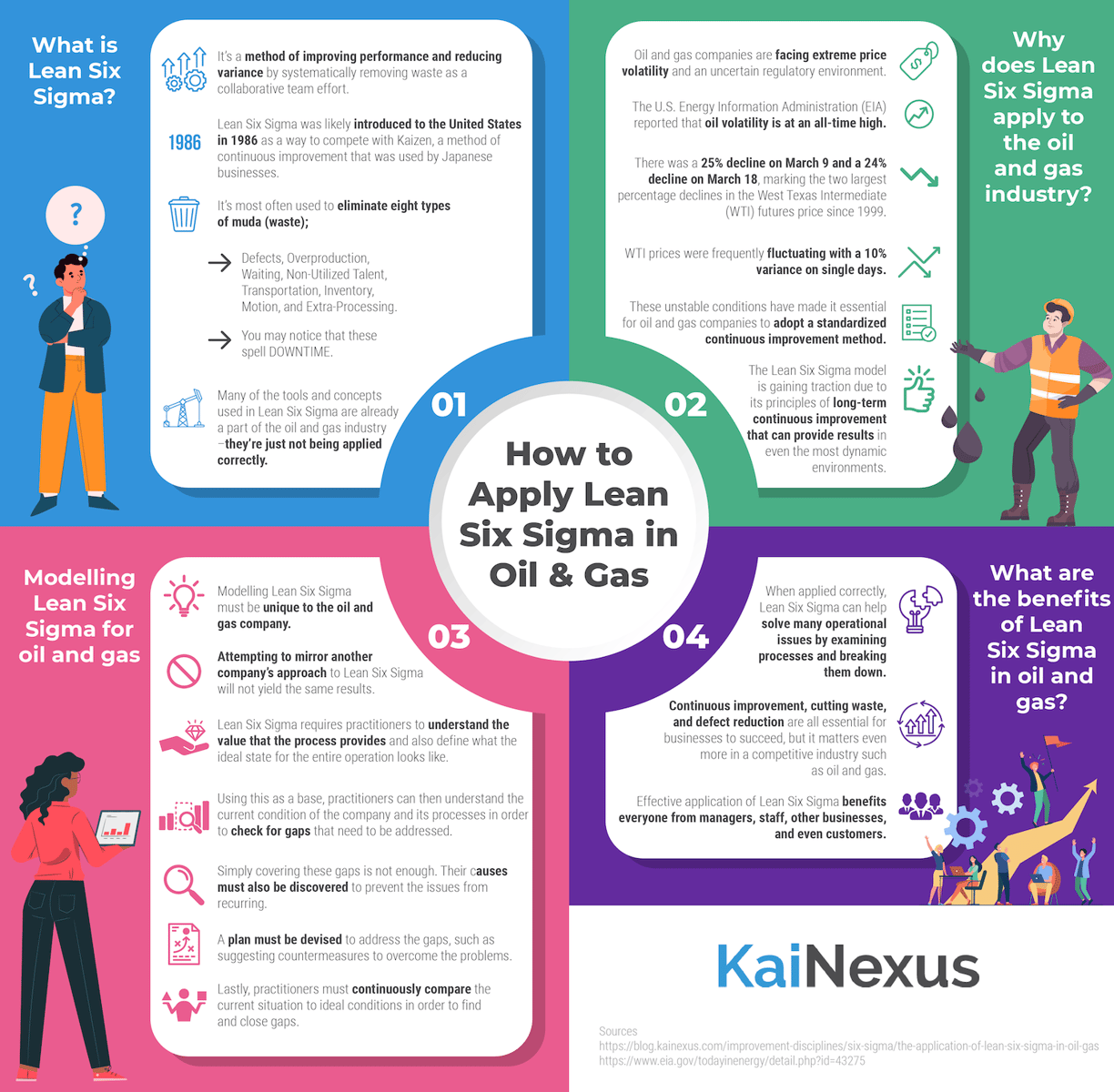 Oil & Gas companies need to be ever more flexible and agile to succeed as the industry continues to face price volatility, technical innovation, and an uncertain regulatory environment. Given these unstable conditions, it’s not surprising that some Oil & Gas companies are reluctant to adopt a standardized continuous improvement method. However, when applied thoughtfully, with an eye on the long-term, the principles of continuous improvement are relevant and can drive results even in the most dynamic environments. That’s why the Lean Six Sigma model is gaining traction in oil & gas.
Oil & Gas companies need to be ever more flexible and agile to succeed as the industry continues to face price volatility, technical innovation, and an uncertain regulatory environment. Given these unstable conditions, it’s not surprising that some Oil & Gas companies are reluctant to adopt a standardized continuous improvement method. However, when applied thoughtfully, with an eye on the long-term, the principles of continuous improvement are relevant and can drive results even in the most dynamic environments. That’s why the Lean Six Sigma model is gaining traction in oil & gas.
Modeling Lean for Oil & Gas
Adopting Lean in the oil and gas industry, like any other non-manufacturing application, requires a deep understanding of the principles that underlie it. Attempting to copy how Toyota or GE does it, for example, tends to result in an approach based on using new tools like 5S or kanban rather than a new way of thinking about how to solve problems. The results of this model are usually random improvements that are difficult to maintain.
When leaders embrace both the principles and practices of Lean and faithfully execute the Plan-Do-Study-Act (PDSA) cycle, they start to see the approach as a system of improvement focused on identifying and resolving the most pressing problems of the organization. The way people think about results and challenges changes, and the organization replaces overly complicated, gut-feel, top-down management with a simpler, more scientific way of functioning.
At its most basic, Lean requires practitioners to:
- Understand what value the process provides
- Define the ideal state for the operation, system, and business
- Understand the current condition and the gaps that need to be closed
- Uncover the root causes for the gaps
- Craft a plan to address the gaps, including suggested countermeasures
- Continue to compare the ideal and current conditions and close new gaps
In the oil & gas sectors, this approach can be applied to individual processes, assets, or the entire organization. The ultimate goal is perfection concerning safety, spills, delays, etc. The point isn’t whether perfection is possible. Everyone should feel like making problems visible and working to correct them is a core function of their job.

Target Improvements
Simplification is a primary objective of the Lean mindset. Of course, the oil & gas sector is inherently complex, so simplification is not easy. However, Lean provides the structure to keep improvement and simplification top of mind. Here are some of the more common ways that Lean is applied in the oil and gas sector.
Capital Projects
Capital projects in the oil and gas sector are unusual in several ways. No oil and gas project is the same as the one that came before it, and lead times can be extremely long. In addition, people often change with each project, bringing a new set of challenges and a new learning curve. This creates problems for boosting performance.
One way to mitigate these challenges is to use project data to determine what drives better performance. Unfortunately, many oil and gas project teams don’t make full use of the data available to them because the data is scattered in hundreds of spreadsheets or even on paper. As a result, data generated from one capital project is lost once it comes to an end.
By adopting the Lean approach and standardizing how data is captured and stored, O&G companies can begin to create a repository of knowledge and build on what is learned during every capital project. Ideally, the information is available to all employees, and executives can track project progress in real-time from anywhere.
Equipment Manufacturing
While all manufacturing companies face normal market demand fluctuations, companies that produce oil and gas equipment must endure a high number of variable factors. Demand for equipment is impacted by changes in legislation, political situations, foreign policy, the logistics of installing heavy equipment, and oil and gas discoveries.
Compared with other manufacturing industries such as automotive and consumer goods, oil and gas equipment is built in tiny quantities and in a custom configuration for a specific application. Much of the equipment is not repetitive of previously manufactured equipment.
Success Stories
Rig Move Improvements
One leading oil and gas company realized that the average rig-move time of its sample fleet that constituted of 8 top rigs was exceeding the business plan by 4 days. This prompted the implementation of Lean Six Sigma to optimize rig-move operations. A special task force team was assigned the task of identifying and reducing inefficiencies in the rig-move process. As a consequence of the DMAIC approach, in Lean Six Sigma, 70 % of the new recommendations were put in effect immediately. A 61 % improvement in rig-move performance was achieved, and an additional 258 days for oil production opportunity was another positive result.
Inventory Optimization
A drilling contractor provides drilling services by utilizing offshore equipment units and drill ships. High availability of the company's fleet is essential for the business and customers satisfaction. Excess and obsolete inventory have a major negative effect on the supply chain's efficiency and management. Lack of inventory visibility was observed since no one knew exactly how much inventory there was in any of the rigs or storage areas. Inventory processes were not documented or well controlled. A special task force team was assigned to identify and reduce inefficiencies in the supply chain process. All deficiencies were identified, resulting in increasing inventory visibility and control, requisitioning efficiency, and accuracy. Inventory management's rollout provided increased inventory visibility with improved cycle counting up to 50% over 2 years.
Key Takeaways
- Lean Six Sigma has many advantages when applied rigorously to any problem, whether operational, managerial, financial, logistic, or other. Good results are guaranteed if all necessary conditions are met initially before taking the process any further.
- Many tools and concepts used in Lean are not new in the oil and gas business. It is also proven from the case studies that Lean approach when applied rigorously can yield effective results by choosing the existing knowledge and appropriate statistics tools.
- Use of Lean Six Sigma guarantees continuous improvements and defect reduction, which is essential for any business's success in a competitive sector such as oil and gas.
- A requirement for success is team cooperation and communication at all managerial and technical levels.
- Some policies could hinder the improvement or the progress of Lean Six Sigma approach. These policies should be relaxed, modified, or even replaced. Managers should not fear any change in the company’s policies for the sake of its progress.
Oil and gas equipment producers have implemented Lean manufacturing and continuous improvement principles to reduce production costs and improve productivity. The O&G sector is increasingly relying on value stream improvement using process mapping to document existing product flows and design future state ideals. Visualization also plays an essential role in controlling flow throughout the manufacturing process.
These are just a few examples of how Lean Six Sigma ideas are being adopted by oil and gas companies. While there is no one-size-fits-all way to “do Lean,” the principles are as applicable and valuable in the energy sector as in almost every other industry.
![[Watch Now] Components of an Employee-Led Lean Initiative](https://no-cache.hubspot.com/cta/default/326641/a91195a9-a959-420e-b46f-d1a97a8175ba.png)


Add a Comment